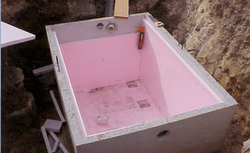OK
I want to put in 2000 gal of storage and I want to have it underground. Right now I'm thinking of two concrete 1000 gal septic tanks side by side and insulated with two layers of two inch foam board then sealed with maybe 4 inches of spray foam by the guy that will spray foam the pex.
Why concrete septic tanks? cheap, $700. each and look at all the themal mass. My question is # 1 will the concrete hold up to heats of high temp water and # 2 will that be enough insulation
Thanks for your thoughts
I want to put in 2000 gal of storage and I want to have it underground. Right now I'm thinking of two concrete 1000 gal septic tanks side by side and insulated with two layers of two inch foam board then sealed with maybe 4 inches of spray foam by the guy that will spray foam the pex.
Why concrete septic tanks? cheap, $700. each and look at all the themal mass. My question is # 1 will the concrete hold up to heats of high temp water and # 2 will that be enough insulation
Thanks for your thoughts



